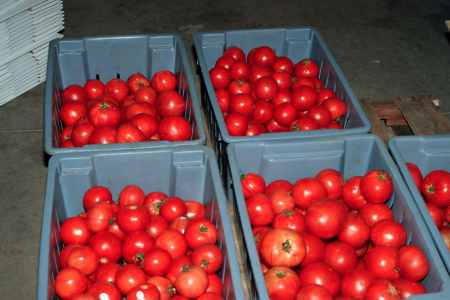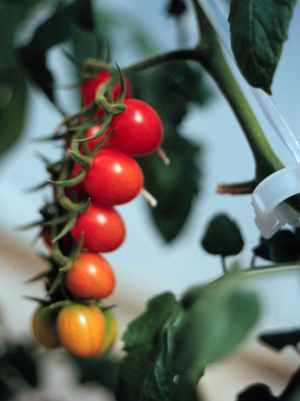| | History | Greenhouse Cultivars | Cropping Cycle | Fertilizer Feed
Commercial greenhouse tomato production in Alberta includes both cluster and beefsteak tomatoes. Cluster tomatoes are also referred to as "truss tomatoes" or "tomatoes on the vine", as they are harvested and sold as complete clusters of 3 to 5 tomatoes still attached to the flowering truss or vine. Beefsteak tomatoes are harvested and sold as individual tomatoes. There is commercial cherry tomato production in Alberta however, the production area is quite small.
This guide is intended to provide basic production information for commercial greenhouse tomato growers. This guide is not a substitute for hands-on tomato production experience but does provide a framework to help base production decisions. The guide presents information on the growing of beefsteak and cluster tomatoes and will make specific references to either type of tomato where production differences exist. In most cases the production of beefsteak and cluster tomatoes is very similar.

Figure1. Beefsteak tomatoes ready for marketIntroduction

Figure 2. Cherry tomatoes
Attainable target yields for new growers for beefsteak and cluster tomatoes are between 50 and 55 kg/m2 of production area. Top Alberta producers have attained over 60 kg/m2 and over 70 kg/m2 in the research production greenhouses at the Crop Diversification Centre South at Brooks. Increased yield comes with increased grower experience and expertise, but the largest incremental yield increases attained by experienced growers comes through the adoption and use of new technology. The skilled use of computerized environmental control systems, newer, taller greenhouses and efficient cooling systems all help to increase yield. The use of carbon dioxide (CO2) supplementation has the potential to increase the yields of a skilled grower who now attains between 55 to 60 kg/m2 , up to 70 kg/m2 .
Recognizing that higher yields are always generally better than lower yields and that yield potential is constrained by a growers ability to control the greenhouse environment, it must be recognized a top-of-the-line greenhouse with all the bells and whistles, which results in a 70 kg/m2 crop, costs considerably more than a greenhouse with a few less bells. A 50 kg/m2 greenhouse can be as profitable as a 70 kg/m2 greenhouse when capital and operating costs are factored in. Technical improvements should be planned to compliment the skill of the grower and the financial means of the business. It is no use to focus on a new CO2 supplementation system if you are not optimizing the rest of your operation. For the CO2 system to pay dividends a grower must be running a finely tuned, top yielding crop with the current greenhouse.
For some greenhouse businesses, the biggest bang for the technical improvement buck might actually be a newer, taller structure. It is important to know where you are, where you want to be and the most logical way to get there. An analogy might be that you wouldn't expect that buying an Indy car would immediately put you in the running to win the race if you were not completely skilled in driving the thing in the first place.
Tomatoes: A brief history
Tomato (Lycopersicon esculentum Mill.) originated in South America and due to its value as a crop it has become to be distributed throughout the world (Taylor 1986). Selection and breeding of the tomato to improve the adaptation of this tropical plant to different environments as well as general improved quality and disease resistance characteristics has been ongoing for approximately 200 years (Stevens and Rick, 1986).
Domestication of the tomato is generally believed to have started in Mexico (Taylor, 1986).
The cherry tomato (L. esculentum. var. cerasiforme) originates in Central America and is the direct ancestor of the modern cultivated tomato (Taylor 1986). Cherry tomatoes are the only wild tomatoes found outside of South America and domestication has included considerable selection for larger fruit (Taylor 1986).
Tomatoes are not tolerant of chilling injury with commercial cultivars sensitive to temperatures below 15°C throughout all stages of plant development (Foolad and Lin 2001). Temperatures in the original South and Central American environment produce an average minimum day temperature of 19oC with an average minimum night temperature of 15°C (Picken et al 1986). The soils in the native range of the tomato are relatively dry (Picken et al 1986). Although tomatoes now thrive in temperatures between 10°C and 30°C they are not frost tolerant and are generally not tolerant of waterlogged soil conditions (Picken et al 1986). However, the cherry tomato is better adapted to wet tropical conditions than any other of the Lycopersicon species, frequently found in areas of high rainfall in Mexico (Taylor 1986).
Commercial greenhouse cultivars
Commercial tomato cultivars can be classed as determinate or indeterminate based on their growth habit. Determinate cultivars produce a branching system that has limited growth to a final form of a bush (Atherton and Harris 1986). Indeterminate cultivars produce branching systems that have the capacity to grow indefinitely that produces a prostrate growth habit (Atherton and Harris 1986). Greenhouse tomato cultivars are indeterminate and require constant maintenance and physical support of the plants to allow for long term fruit production.
Cultivar selection is based on the type of tomato to be grown, cluster or beefsteak, high yield potential under Alberta growing conditions, and disease resistance. Fruit quality characteristics such as size, colour, taste, shelf life and resistance to shrink cracking are also important. A short calyx is also desirable since a long calyx on the fruit can damage adjacent fruit during packing. The market is the ultimate authority on whether a cultivar meets the requirements of the consumer, and growers are well advised to grow the market proven cultivars. The 'best' cultivars are subject to change as seed companies are constantly working to develop greenhouse tomato cultivars with improved quality characteristics.
Commercial cropping cycle
The greenhouse tomato production cycle is based on using the same set of plants for full year. The plants are seeded in mid November, with harvest beginning at the end of March to early April and continuing through to the following November. An approximate yield target for introductory growers would be 50 kg/m2 for beefsteak or cluster tomatoes.
Fertilizer Feed
The feed program is designed in such a way as to deliver adequate nutrition throughout the productive life of the plant. There are arguments made for the changing nutritional requirements of plants as they grow to maturity and fruit production, and these arguments are valid. There are related arguments about changing the nutrient levels in the feed to accommodate the changing nutritional requirements of the plants. This too, has merit. However, the feed targets presented in this manual (Table 1) are designed to provide adequate nutrition throughout all stages of the crop, and will make it possible for growers to obtain maximum yields and have been used to reach yields in excess of 60 kg/m2 of tomatoes.
Table 1. Nutrient feed targets (ppm) for greenhouse tomatoes in sawdust.
| Nutrient | Target (ppm) |
| Nitrogen | 200 |
| Phosphorus | 55 |
| Potassium | 300 |
| Calcium | 200 |
| Magnesium | 55 |
| Iron | 3.00 |
| Manganese | 0.50 |
| Copper | 0.12 |
| Molybdenum | 0.12 |
| Zinc | 0.20 |
| Boron | 0.90 |
| Target E.C. | 2.5 mmho |
| Target pH | 5.8 |
|
|